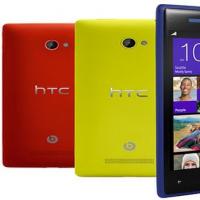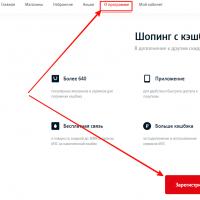What is volte in a smartphone. VoLTE on Xiaomi: what it is and how to disable this feature. VoLTE in Russia
In 2012, I noticed that some of my acquaintances were heard much better when calling on their mobiles than everyone else. The difference was so significant that I began to ask the interlocutors what kind of phones they were using (it was easier to define the operator then because there was no possibility of porting the number). It turned out that we are talking about a bunch of smartphones Sony Xperia and MTS, which began to implement HD Voice technology. Then I found out that since 2010 HD Voice has been working for MegaFon, but for some reason I did not notice a similar contrast, although the main operator at that moment was just him.
The human voice is in the range from 80 to 14,000 hertz, but before HD Voice it was placed in the Procrustean bed of 300-3400 Hz, which, of course, was hard to miss. HD Voice has expanded the range to 50-7000 Hz. This is also not ideal, but much, much better.
On the Beeline website, HD Voice was seen for some reason like this
Over time, the list of smartphones supporting HD Voice has expanded significantly, and today it is difficult to find a device that would not be able to do this. But still, the voice does not always sound good enough. Especially as carriers prioritize Internet traffic and voice has to be content with remaining bandwidth. Messengers "sound" better, but, as they say, there is no stability.
I discussed this topic while working on the project "Russia at the Speed of a Digital" and was advised to try VoLTE technology. Using the rough language of Wikipedia, I will say that it is “a voice over LTE technology based on the IP Multimedia Subsystem (IMS). Allows to provide voice services and deliver them as data stream over LTE. VoLTE has three times more voice and data capacity than 3G UMTS networks and up to six times more than 2G GSM networks. It also frees up bandwidth because packet headers are smaller than non-optimized VoIP / LTE. "
At the time of this writing (March 5, 2018) VoLTE actually and officially works only with MegaFon. Beeline launched support in Moscow on six rather exotic smartphones, but then turned it off on them too. Tele2's VoLTE seems to function on three smartphones released under its own brand, but they are so dead (in the sense of smartphones) that I didn't really want to buy for the test. MegaFon has an impressive list (), and it includes the flagships of Apple, LG, Samsung and even Nokia. According to unofficial reports, VoLTE is enabled on some ZTEs. Taking into account the fact that to use VoLTE in MegaFon, it is enough just to have a SIM card with 4G + support, there are plenty of opportunities to test the technology in action.
But why?
If you think that VoLTE is just an improvement in voice quality, then no, everything is a little more interesting.
First, Internet access is not interrupted during a call. And if during a regular call, when a smartphone is in hand, this is not particularly critical, then when using online navigation, having access to the Network is very important.
 Over the hill, VoLTE implementation is also a source of pride and so far not too common.
Over the hill, VoLTE implementation is also a source of pride and so far not too common. Secondly, the connection setup speed is drastically reduced. Sometimes just instantly, sometimes you have to wait 1-2 seconds. It's just nice.
And thirdly, yes - the voice is really better. This is especially noticeable in MegaFon, which has long prioritized the Internet, which is why ordinary voice calls have acquired a strong taste of metal. When making calls on LTE, naturalness returns.
I was interested in the question - how does the use of VoLTE affect the battery life? On the forums, they say that either in no way, or it works a little longer. Running a little ahead, I will say that my impression is rather closer to "no way". But no less, it's already good.

Also, the use of technology does not affect costs, everything remains within the selected tariff plan. Internet traffic used for voice does not consume Internet package.
For the operator, the benefit of VoLTE is the ability to use frequencies more efficiently (remember about tripled voice capacity). The owners of tariffs with a large number of prepaid minutes usually use fairly modern devices, and if you drag them to LTE, everyone will be better.
Where does it work?
At the moment, experiments with VoLTE for all operators are limited to Moscow and the Moscow region. When traveling to neighboring regions, the magic disappears. Also, a SIM card from another region, once in Moscow, will not start supporting VoLTE.
If the interlocutor, who is on the network of the same operator, has a smartphone that does not support VoLTE, the voice transmission quality will not improve, but the connection speed will still be high, and the ability to transfer data during a call will not disappear. When you call a subscriber of another operator, the only bonus will be the Internet during the conversation, because the connection speed already depends not only on your operator.
If a person calls you from an outdated device (or operator), your voice will still go over LTE, but the codec will be used as usual. Therefore, the quality of voice transmission will not increase.
Go!
Armed with all this knowledge, I went to the MegaFon salon for a SIM card. The staff were not very aware of how to make VoLTE work. In particular, it is not clear from the official description - whether any tariff is suitable or only the option from the new “Turn on” set. For greater reliability, I connected “Turn on! Write. "

The first experience of immersing in VoLTE was not very successful: despite the fact that LG G6 (870DS) is on the list of supported, the technology did not work. Neither an item in the menu nor a characteristic icon appeared in the service line. I rearranged the SIM card in the Sony Xperia XZ Premium, and that's where everything was hooked. This is, of course, a little strange, but oh well.
MegaFon honestly warns that the services "Personal dial tone", "AntiAON", "One-off AntiAON" and "Who called +" do not work in VoLTE mode. As far as I understand, the point is that traffic goes through LTE, and the existing equipment cannot interface it with some services. In the future, these restrictions will probably disappear.
It is easy to find out about the presence of VoLTE on Sony Xperia XZ Premium by the impressive size of the logo in the service line. When switching to 3G and 2G networks, the logo disappears. The active call is not interrupted, but the voice quality changes. In general, it is no wonder: this changes the codec, from AMR WB (Adaptive multi rate wide band, also known as G.722.2) to AM NB (Adaptive multi rate narrow band).

As for the quality of the VoLTE conversation, it is really excellent. The frequency range expands to 16,000 Hz, that is, even more than is needed to convey all shades of voice. The bitrate depends on the specific device and the settings of the network segment, so fluctuations in the range from 12.65 to 23.85 Kbps are possible. Audiophiles may shudder after such numbers, but still the voice is not a jazz concert, and that's enough. The voice breathes, lives, and the difference with the sound of MegaFon in less advanced modes is very significant.
Peep the future
In the comments to the post on Facebook, where I announced the beginning of experiments with VoLTE, I was told that MTS also has this technology. More precisely, it is being tested, but you can get involved without much effort. Why this time the operator decided to launch the technology synchronously with his colleagues - I don't know. Perhaps, for once, they decided not to play catch-up, but to finish it so that it becomes available to the maximum number of clients and "makes friends" with the already working services. In test mode, VoLTE from MTS is available on all current iPhones, starting with SE, as well as on Motorola Moto C Plus and some models of devices under its own brand. Requires iOS 11.3 public beta to be installed on iPhone.

I haven't experimented with iPhone beta for a long time. Since then, when they had to be downloaded and installed from a computer via a cord. But now, after registering for the beta testing program, everything comes over the air through the standard update menu, which is nice.
The beta installation was even smoother than the other final version. No icons appeared in the service bar, Apple doesn't like that. In fact, the only way to detect VoLTE support of devices is the LTE icon during a call. And, of course, other goodies - fast connection, access to the Network via LTE during a call and increased voice quality.

Together with iOS 11.3 Beta2, Wi-Fi Calling technology came to the iPhone, which I just enjoyed since the days of Samsung Galaxy S7, where it first appeared in conjunction with the MTS network. In the editorial office, the usual connection at times did not work very well, but with Wi-Fi all problems immediately disappeared. Well, Wi-Fi Calling saved me a lot of money while traveling abroad, because the conditions of the home region apply with it, even if you do not connect any additional services to minimize costs. That is, incoming calls are free, outgoing calls use a regular package of minutes.
Already in test mode, the iPhone during a call switches from VoLTE to Wi-Fi Calling and to other standards smoothly and without interruptions. The codec in 3G and 2G naturally changes. It should be noted that it was with Wi-Fi Calling on the iPhone in iOS 11.3 Beta 2 that there were roughnesses (long connection and very high requirements for the quality of the Wi-Fi signal, you had to stand right next to the router), but already in Beta3 this was fixed in Beta4 it didn't get any worse.
 In the service line, when switching to iOS 11.3, the name of the operator is changed
In the service line, when switching to iOS 11.3, the name of the operator is changed When making calls within the Moscow MTS network, the voice quality is marvelous, but taking into account the fact that the interlocutors communicate not only through one operator, but also using smartphones of an expensive brand, another cannot be expected. When calling MegaFon subscribers with VoLTE connected, a funny picture is observed: it seems to work for each interlocutor, but somewhere along the way at the switch level, everything is cut to the usual level. I am sure that one day the operators will make special gateways, but so far, unfortunately, miracles of progress are possible only within one network.
Nothing is known about the restrictions on services in the MTS network. All the details will be in the official version of iOS 11.3, which is expected in mid-March.
Total
The tremendous progress in the field of mobile Internet over the past ten years has practically not affected the quality of voice transmission. Voice and data seemed to live in the same room, but did not communicate, but they created a lot of inconveniences for each other. VoLTE removes this strange disharmony, allowing the operator to stop being torn between voice and data communications.
 The usual communication after VoLTE will seem to you an unpleasant archaism.
The usual communication after VoLTE will seem to you an unpleasant archaism. Of course, there is still a long way to go before the complete victory of the new technology. Beeline started experiments in 2015 and stopped them. Since September 2016, MegaFon has not gone beyond the Moscow Region, and not everything is smooth inside it. “Implementation” of Tele2 cannot be seriously considered. MTS also works only in Moscow and the Moscow region, and although the first impression is good (especially considering the expansion of Wi-Fi Calling support on the iPhone), it is too early to talk seriously about the quality of work before the start of mass use.
From a user point of view, switching from a regular codec to AMR WB is like from a cassette tape to CD. And the operators can be safely classified as well: this one also sells cassette players, and this one already sells CD-players. Having compared it once, it won't pull back.
Now I'm wondering who will be the first to leave the Moscow region. What are your bets?
VoLTE support is one of the characteristics of a smartphone that is increasingly talked about at presentations. Today we will tell you what this function is and why it is needed.
VoLTE is a technology that allows voice to be transmitted over 4G networks. This is one of the standards that emerged as a result of the improvement of communication channels. Remember, mobile phones were originally designed for calls only. Even the function of sending SMS messages appeared a little later.
Over time, telephones began to support new standards for data transmission, including GPRS. However, voice calls remained the priority format for communication using the telephone. Now everything has changed.
Users are increasingly resorting to high-speed communication standards that allow data to be transferred as quickly as possible. Fourth generation (LTE) commercial networks are traffic oriented, while voice transmission has so far been carried out over 2G or 3G. Until recently, there were no other options. But then VoLTE came along.
Now our smartphones are constantly switching between different communication standards, switching either to the Internet traffic channel or to the voice communication zone. These manipulations significantly affect performance and battery level. discharges quickly. And VoLTE will solve the problem, since you can communicate and transfer data through one communication channel.
Support for VoLTE technology does not require a smartphone to constantly switch between old networks. Theoretically, the new technology will allow completely abandoning 2G and 3G equipment in the future.
The main advantages of VoLTE:
- Instant connection. The absence of the need to switch to another standard speeds up the connection with the subscriber. Sometimes the gain in speed reaches 30 seconds.
- Free communication. Since a conversation via VoLTE involves the use of Internet traffic, you only need to pay for the Internet. By connecting an unlimited package, you can communicate by phone at least around the clock. And all this will be free.
- Improving the quality of communication. The 3G connection significantly spoils the sound quality and does not allow it to be transmitted perfectly. The new standard will eliminate extraneous noise and make the sound more spacious.
- Increasing the capacity of cellular networks. 3G bases are designed for a limited number of subscribers. Exceeding this value leads to a deterioration in the signal quality. The capacity of LTE equipment is three times higher than that of third generation networks and six times higher than that of second generation networks.
- Possibility of simultaneous traffic and voice transmission. Now, when talking on the phone, the Internet connection is disconnected. Receiving traffic will resume only after the subscriber hangs up. VoLTE doesn't have this problem. Therefore, the exchange of data will continue even while talking on the phone.
Unfortunately, in Russia, fourth-generation networks are not yet widespread, although in other countries of the world the technology for voice transmission over LTE is actively developing. Progress is subtle and slow. Mobile providers and operators are gradually launching fourth-generation networks, but more often this happens only within Moscow.
If you bought a smartphone with VoLTE support, but this technology is not available in your region, you should not deactivate the module. The function does not consume battery power and does not require additional resources from the device.
At the moment, when choosing a smartphone, this option is not a priority. It is worth paying attention to VoLTE support if you often travel or live in Moscow. Thanks to the new standard, you will experience a completely different quality of communication, as well as appreciate the increased autonomy of your phone due to the economical consumption of battery power.
In May 2014, Singapore-based SingTel introduced the world's first commercial VoLTE service operating in Singapore. Interestingly, initially it worked with only one smartphone - Samsung Galaxy Note 3. Later the technology was developed in other countries - Russia was no exception.
Users often ask the question - what is this very VoLTE? The term VoLTE itself was formed from several words: Voice over LTE, which can be translated as “voice over LTE”. Yes, it is indeed a voice transmission technology, which in turn is based on IP Multimedia Subsystem (IMS) technology.
What does VoLTE give? This technology allows you to provide voice services and deliver them as a data stream over LTE, has several times greater data capacity and voice capacity than 3G networks, and even more so 2G. VoLTE also frees up bandwidth.

But all this is lyrics. It is much more important for the user to know what advantages and disadvantages this technology has. We will tell you about them.
VoLTE advantages
- First and foremost - now there is no need to waste time to make a call. Understood nothing? We explain: before, in order to make a call, the system automatically switched the device from 4G mode to 3G mode, which could take about 2 seconds. Now you do not need to switch anything, the device makes a call immediately.
- The second advantage, and not less important, is that the quality of the transmitted sound has improved, in some cases - at times.
- Third: when making a call, you can transfer data in the 4G network. This was not possible before, because, as mentioned above, the device switched to 3G mode.
- The fourth advantage will not be noticed by the majority of users: the number of subscribers that can maintain simultaneous communication with one base station increases.
Disadvantages of VoLTE
- There may be such a problem: when leaving a city where there are no LTE towers, the connection may be lost. You need to switch to 3G mode yourself.
- The second is a higher load on the device itself, that is, it can discharge faster. True, the load is small, so there is no need to worry about the fact that the smartphone suddenly starts to discharge quickly.
Addition
On smartphones, VoLTE is turned on by default, and a corresponding icon appears in the status bar, which may have the name VoLTE or, for example, HD, as in our example:

You can disable this function at any time, or, conversely, enable it. We do not see any sense in disconnecting, but if you want to do this, then here is a simple instruction for you.
Open the Settings app from the desktop icon.

Click on the "More" button.

Select Mobile Network.

If you have a different layout of subsections in the "Settings" section, it does not matter - use the search by the phrases "mobile network" or "mobile networks" (without quotes).
Find the line "VoLTE calls" and enable or disable the specified functionality.

Not that hard, is it?
Looking through the list of characteristics of a smartphone, you can stumble upon a mention of VoLTE. With conventional LTE, everything is clear - this is a type of wireless communication that allows you to receive and transmit data at high speeds. And VoLTE - what is it in a phone? In short, this is a technology that allows not only traffic, but also voice to be transmitted over 4G networks. But let's touch on this topic in a little more detail.
Initially, cell phones were designed only for making calls, even the ability to exchange SMS messages did not appear immediately. First-generation cellular networks actually carried only voice, most often even in unencrypted form. Only with the onset of the 2G era did different data transmission standards appear, including the familiar to many GPRS. But the priority in those days continued to be given to voice communication, the Internet connection was still used by very few owners of mobile phones.
Now the situation has changed dramatically. Each new standard of cellular communication is tailored for an ever increasing data transfer rate. It got to the point that the fourth generation (LTE) is completely sharpened only for the transmission of Internet traffic. Voice calls are still made via 2G or 3G, there are no other options. Not until recently.
The main advantages of VoLTE
Now almost all major cities have LTE networks. In theory, a smartphone could work only in them, without wasting energy for switching between different communication standards. However, an outgoing or incoming call forces the system to use the 3G connection. Each such synchronization consumes a certain amount of charge. VoLTE technology solves this problem. This function, roughly speaking, consists in transmitting voice in digital form, using 4G networks for this. With the support of this technology, voice calls will no longer force the device to connect to networks of previous generations. And in the future, this (purely theoretically) will allow telecom operators to abandon support for 2G and 3G equipment. But to do this, you need to wait for the moment when the population will have no old mobile phones left that do not have LTE support and, most importantly, VoLTE.

In fact, the new technology has other advantages as well:
- Fast connection. If the phone does not waste time on the transition to 2G or 3G, then the call is made much faster. Sometimes the gain in speed reaches 30 seconds.
- Calls may become free. In fact, a VoLTE conversation only consumes Internet traffic. If unlimited Internet is connected, then an outgoing call will not spend a single extra ruble. You can talk even day and night.
- Improving the quality of the voice. No matter how high-quality the microphone is on the smartphone, the 3G connection spoils everything. This communication standard simply cannot deliver perfect sound. And VoLTE is limited only by the stability of the signal reception. If the device supports the HD Voice codec, then the voice will become three-dimensional, and extraneous noise will disappear.
- Increasing the capacity of cellular networks. A limited number of subscribers can connect to each 3G base. If the limit is exhausted, the device connects to a more distant base, and the connection deteriorates. LTE equipment has three times the capacity of 3G and six times that of 2G.
- Simultaneous transmission of voice and traffic. When there is a conversation on the phone, none of the applications can receive data from the global web. Receiving traffic will resume only after the subscriber hangs up. VoLTE technology has solved this problem - messages in messengers will continue to flow even during a call.
Modern smartphones with VoLTE
Support for the new type of communication is available in many devices, even in relatively inexpensive ones. For example, the corresponding technology is built into the Xiaomi Redmi 4X. This smartphone is among the most. People love the low price tag and optimal performance.
Of course, many are endowed with VoLTE support. In theory, the Samsung Galaxy S8 and Mi6 allow to talk via LTE networks. In less expensive devices, VoLTE is also found - for example, Meizu M5 Note and iPhone SE are endowed with the corresponding technology.

Russian operators
If smartphone manufacturers already support voice over LTE with might and main, then this cannot be said about telecom operators. In Russia, it is still more profitable to use equipment that works with networks of previous generations, reserving 4G only for Internet traffic. Progress is being made in this area, but very slow. Here's how things are with different Russian operators:
- "Megaphone" launched VoLTE, but only in Moscow. Moreover, this function was initially allowed to be activated only by owners of smartphones and Apple. At the time of this writing, the list of devices has expanded to almost 40 models, including synchronization with VoLTE available on, ZTE V8, Vertex Saturn and LG G6.
- MTS just testing new technology. The press releases have repeatedly stated that the commercial operation of VoLTE will be launched in 2018. It is assumed that a new type of communication will be available not only in Moscow.
- Beeline gave its Moscow subscribers the opportunity to try VoLTE back in 2015. But testing was quickly completed, and since then there has been no news from VimpelCom. They say that owners using Beeline services will soon be able to speak on VoLTE, but these are just rumors.
- Tele2 launched a new type of communication in April 2017, but only in Moscow. The list of supported smartphones is strictly limited. Moreover, you can feel the "super-quality" of the voice only when talking within the network.
Disable VoLTE
Some people prefer to disable all modules that are not being used for some reason. VoLTE deactivation does not make sense, because this function does not consume additional amounts of energy. On the contrary, this technology will save battery power if the operator suddenly starts supporting it.
However, it is very easy to disable VoLTE. To do this, follow the path: "Settings -> Connections -> Mobile networks -> VoLTE calls"... All that remains here is to deactivate the corresponding switch. Please note that the path may differ on some smartphones.

Conclusion
When choosing a smartphone, you should not seriously pay attention to the VoLTE function, since Russian operators so far have only limited support for the technology. The only exceptions are residents of Moscow - they are the easiest to use the new type of communication. However, technologies are developing, operators are gradually purchasing new equipment. It is possible that one day support for VoLTE technology will appear in your city. Therefore, the function will definitely not be superfluous.
Note. To use VoLTE, the device must have specialized system software from the operator, and the subscription (including the SIM card) must support VoLTE service for your device model. Contact your network operator to find out if your device, software, subscription, and SIM card support VoLTE.
Android ™ 8.0
Enabling VoLTE
- Find and tap Settings > Network and Internet > Mobile network > Network type > LTE or 4G (preferred) / 3G / GSM.
- Enable VoLTE Enable VoLTE
Android ™ 5.0, 5.1, 6.0, 7.0, 7.1 or 7.1.1
Enabling VoLTE
- Make sure your Xperia ™ device model and your subscription support VoLTE.
- Find and tap Settings > Yet > Mobile network > Network type > LTE or 4G (preferred) / 3G / GSM.
- Tap the switch next to Enable VoLTE to enable VoLTE. If item Enable VoLTE missing, contact your network operator.
 Can I use Google Play Market on Lumia?
Can I use Google Play Market on Lumia? Description and secrets of the current tariff zero doubts on the beeline
Description and secrets of the current tariff zero doubts on the beeline MTS option “Russia is at home everywhere
MTS option “Russia is at home everywhere Seamless Wi-Fi Useful reviews about the work of capsman
Seamless Wi-Fi Useful reviews about the work of capsman How to talk to Alice Screenshots Yandex with Alice
How to talk to Alice Screenshots Yandex with Alice Mts bonus program is closed
Mts bonus program is closed Mobile communications and internet in the resorts of montenegro
Mobile communications and internet in the resorts of montenegro